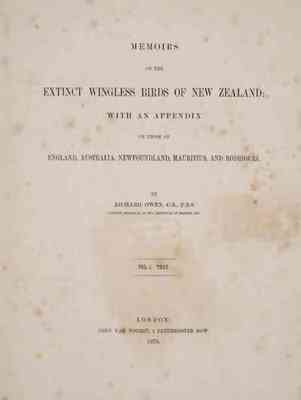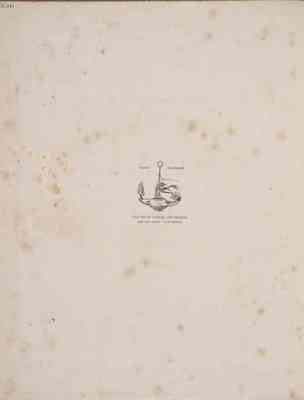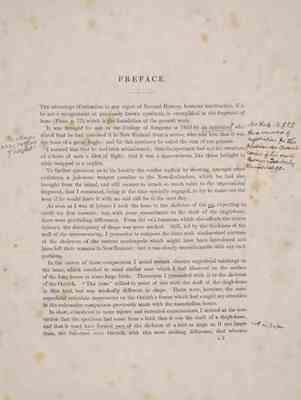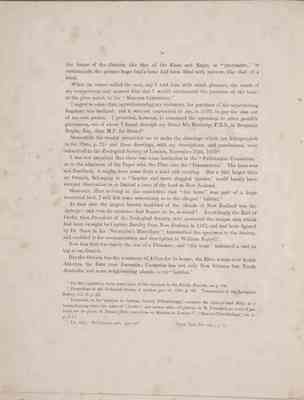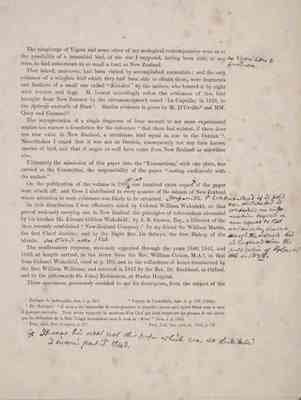Pages
11
MEMOIRS ON THE EXTINCT WINGLESS BIRDS OF NEW ZEALAND; WITH AN APPENDIX ON THOSE OF ENGLAND, AUSTRALIA, NEWFOUNDLAND, MAURITIUS, AND RODRIGUEZ.
BY RICHARD OWEN, C.B., F.R.S. FOREIGN ASSOCIATE OF THE INSTITUTE OF FRANCE, ETC. VOL. I. TEXT.
LONDON: JOHN VAN VOORST, 1 PATERNOSTER ROW. 1879.
13
PREFACE.
The advantage of attention to any object of Natural History, however unattractive, if it be not a recognizable or previously known specimen, is exemplified in the fragment of bone (Plate, p. 73) which is the foundation of the present work.
It was brought for sale to the College of Surgeons in 1839 by an individual* who [right margin: Mr Rule M.R.C.S. for a narration of negotiations for this purchase see Owen's review of his own labours. [??] Review. Vol 90.] stated that he had obtained it in New Zealand from a native, who told him that it was the bone of a great Eagle: and for this specimen he asked the sum of ten guineas. [left margin: The Maori knew nothing of Eagles.]
I assured him that he had been misinformed: that the specimen had not the structure of a bone of such a bird of flight; that it was a marrow-bone, like those brought to table wrapped in a napkin.
To further questions as to its locality the vendor replied by showing, amongst other evidences, a jadestone weapon peculiar to the New-Zealanders, which he had also brought from the island, and still seemed to attach so much value to the unpromising fragment, that I consented, being at the time specially engaged, to try to make out the bone if he would leave it with me and call for it the next day.
As soon as I was at leisure I took the bone to the skeleton of the ox, expecting to verify my first surmise ; but, with some resemblance to the shaft of the thigh-bone, there were precluding differences. From the ox's humerus, which also affords the tavern delicacy, the discrepancy of shape was more marked. Still, led by the thickness of the wall of the marrow-cavity, I proceeded to compare the bone with similar-sized portions of the skeletons of the various quadrupeds which might have been introduced and have left their remains in New Zealand ; but it was clearly unconformable with any such portions.
In the course of these comparisons I noted certain obscure superficial markings on the bone, which recalled to mind similar ones which I had observed on the surface of the long bones in some large birds. Thereupon I proceeded with it to the skeleton of the Ostrich. "The bone" tallied in point of size with the shaft of the thigh-bone in that bird, but was markedly different in shape. There were, however, the same superficial reticulate impressions on the Ostrich's femur which had caught my attention in the exhaustive comparison previously made with the mammalian bones.
In short, stimulated to more minute and extended examinations, I arrived at the conviction that the specimen had come from a bird, that it was the shaft of a thigh-bone, and that it must have formed part of the skeleton of a bird as large as, if not larger [right margin: not in paper.] than, the full-sized male Ostrich, with this more striking difference, that whereas A2
14
iv the femur of the Ostrich, like that of the Rhea and Eagle, is "pneumatic", or contains air, the present huge bird's bone had been filled with marrow, like that of a beast.
When its owner called the next day I told him, with much pleasure, the result of my comparisons, and assured him that I would recommend the purchase of the bone, at the price asked, to the "Museum Committee."
I regret to relate that, notwithstanding my testimony, the purchase of the unpromising fragment was declined ; and it was not convenient to me, in 1839, to pay the sum out of my own pocket. I promised, however, to commend the specimen to other possible purchasers, one of whom I found, through my friend Mr. Broderip, F.R.S., in Benjamin Bright, Esq., then M.P. for Bristol 1.
Meanwhile the vendor permitted me to make the drawings which are lithographed in the Plate, p. 73 ; and these drawings, with my descriptions and conclusions, were submitted to the Zoological Society of London, November 12th, 18392.
I was not surprised that there was some hesitation in the "Publication Committee" as to the admission of the Paper with the Plate into the 'Transactions.' The bone was not fossilized ; it might have come from a kind still existing. But a bird larger than an Ostrich, belonging to a "heavier and more sluggish species," could hardly have escaped observation in so limited a tract of dry land as New Zealand.
Moreover, after arriving at the conviction that "the bone" was part of a huge terrestrial bird, I still felt some uncertaintly as to the alleged "habitat."
At that date the largest known land-bird of the islands of New Zealand was the Apteryx ; and even its existence had begun to be doubted3. Accordingly the Earl of Derby, then President of the Zoological Society, who possessed the unique skin which had been brought by Captain Barclay from New Zealand in 1812, and had been figured by Dr. Shaw in his 'Naturalist's Miscellany'4, transmitted the specimen to the Society, and confided it for re-examination and description to William Yarrell5.
Now this bird was barely the size of a pheasant ; and "the bone" indicated a bird as big as an Ostrich.
But the Ostrich has the continent of Africa for its home ; the Rhea roams over South America, the Emu over Australia ; Casuarius has not only New Guinea but North Australia, and some neighbouring islands, as its "habitat".
1 For the acquisition, many years later, of this specimen by the British Museum, see p. 149. 2 Proceedings of the Zoological Society of London, part vii. 1839. Transactions of the Zoological Society, vol. iii. p. 29. 3Temminck, in his 'Analyse du Système Général d'Ornithologie,' relegates the Apteryx and Didus to a terminal group under the name of "Inertes;" and Lesson asks:--L'Apteryx de M. Temminck ne scroit-il pas fondé sur les pièces de Dronte (Dodo conservées au Museum de Londres?" ('Manuel d'Ornithologie,' vol. ii. p. 211.) 4 Vol. xxiv. "Ferruginous-grey Apteryx." 5Trans. Zool. Soc. vol. i, p. 71.
15
v
The misgivings of Vigors and some other of my zoological contemporaries were as to the possibility of a terrestrial bird, of the size I supposed, having been able, at any [right margin: see Vigors letters to Swainson.] time, to find subsistence in so small a tract as New Zealand.
That island, moreover, had been visited by accomplished naturalists ; and the only evidence of a wingless bird which they had been able to obtain there, were fragments and feathers of a small one called "kivi-kivi" by the natives, who hunted it by night with torches and dogs. M. Lesson accordingly refers the evidences of this bird brought from New Zealand by the circumnavigatory vessel 'La Coquille,' in 1828, to the Apteryx australis of Shaw1. Similar evidence is given by M. D'Urville2 and MM. Quoy and Gaimard3.
The interpretation of a single fragment of bone seemed to my more experienced seniors too narrow a foundation for the inference "that there had existed, if there does not now exist, in New Zealand, a struthious bird equal in size to the Ostrich"4; Nevertheless I urged that it was not an Ostrich, consequently not any then known species of bird, and that it might as well have come from new Zealand as anywhere else.
Ultimately the admission of this paper into the 'Transactions,' with one plate, was carried at the Committee, the responsibility of the paper "resting exclusively with the author."
On the publication of the volume in 1838, 9-40one hundred extra copies* of the paper were struck off ; and these I distributed in every quarter of the islands of New Zealand where attention to such evidences was likely to be attracted. [handwritten: Impossible and untrue - And if it had been distributed it contained no information beyond or even equal to that universally known through the land. And in England since the publication of Polack's book in 1838.]
In this distribution I was efficiently aided by Colonel William Wakefield, at that period zealously carrying out in New Zealand the principles of colonization advocated by his brother Mr. Edward Gibbon Wakefield ; by J. R. Gowen, Esq., a Director of the then recently established "New-Zealand Company;" by my friend Sir William Martin, the first Chief Justice ; and by the Right Rev. Dr. Selwyn, the first Bishop of the islands. [handwritten: see Owen's note 1843.]
The confirmatory response, anxiously expected through the years 1840, 1841, and 1842, at length arrived, in the letter from the Rev. William Cotton, M.A.5, in that from Colonel Wakefield, cited at p.109, and in the collections of bones transmitted by the Rev. William Williams, and received in 1843 by the Rev. Dr Buckland, at Oxford, and by Dr. (afterwards Sir John) Richardson, as Haslar Hospital.
These specimens, generously confided to me for description, form the subject of the
1. Zoologie de la Coquille, tom. i. p. 418. 2. Voyage de l'Astrolabe, tom. ii. p. 480 (1832). 3. Ib. 'Zoologie.' "Il nous a été impossible de nous procurer le singulier oiseau qu'a figuré Shaw sous le nom d'Apteryx australis. Nous avons rapporté le manteau d'un Chef qui était recouvert des plumes de cet oiseau que les Zélandais de la Baie Tolaga connaissent sous le nom de 'Kiwi' " (tom. i. p. 158). 4. Proc. Zool. Soc. at sapra. p. 171. 5. Proc. Zool. Soc. part xi. 1843. p. 74.
[handwritten: *It was his next not this paper which was so distributed Denques part. I. 1843.]
